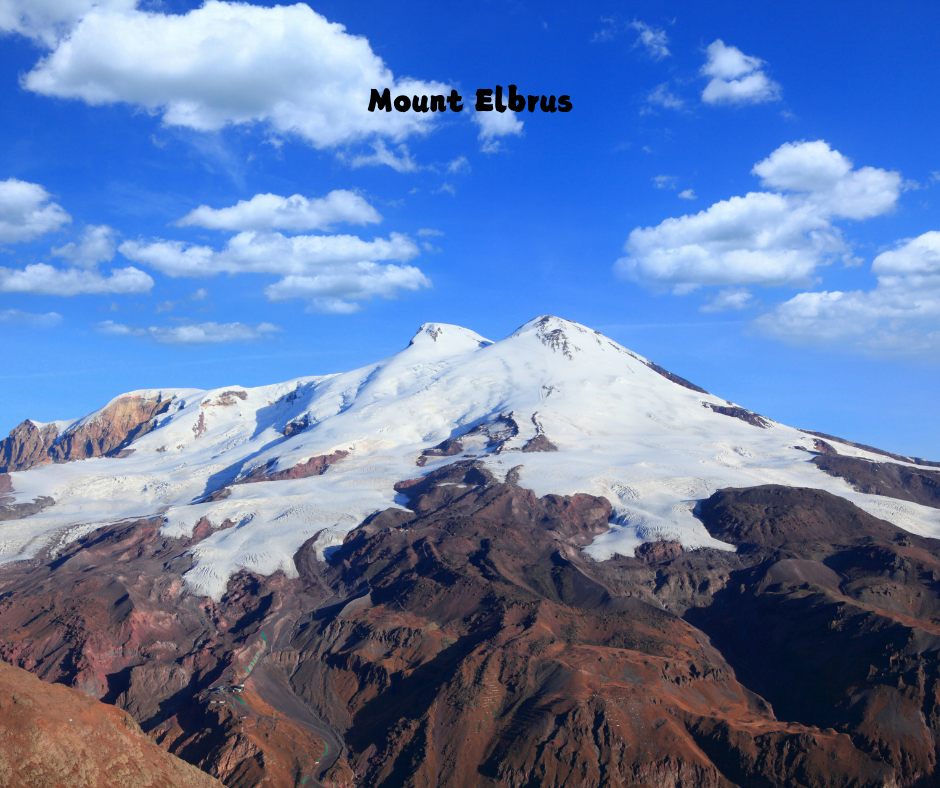Conquering Mount Elbrus: Europe’s Highest Peak
Mount Elbrus, standing at 5,642 meters (18,510 feet), is the tallest mountain in Europe. And one of the Seven Summits, the highest mountains on each of the seven continents. Located in the Caucasus Mountains of Russia, near the border with Georgia, Elbrus is a dormant stratovolcano, with its last eruption estimated to have occurred around 50 AD. This iconic peak, with its twin summits and expansive glaciers, has a long history of mountaineering, adventure, and cultural significance. In this blog, we will explore the geological history of Mount Elbrus. Its climbing routes and challenges, its cultural and historical importance, and the environmental considerations of visiting this majestic mountain.
Geological History of Mount Elbrus
Mount Elbrus is part of the Greater Caucasus Mountain Range, which extends from the Black Sea in the west to the Caspian Sea in the east. The Caucasus Mountains formed approximately 25 million years ago due to the collision of the Arabian and Eurasian tectonic plates. Its a process that continues today, contributing to the region’s geological instability and seismic activity.
Elbrus itself a stratovolcano, meaning built up by many layers of hardened lava, tephra, pumice, and volcanic ash. It has two summits, the west (5,642 meters) and the east (5,621 meters), with a saddle between them. The volcano is considered dormant, with its last known eruption occurring in antiquity. However, volcanic activity is still evident in the form of hot springs and fumaroles on the slopes of the mountain, indicating that magma chambers beneath the surface remain active.
The glaciers on Mount Elbrus cover an area of about 125 square kilometers (48 square miles), making them the largest glacial system in the Caucasus. These glaciers feed several rivers that flow into the Caspian and Black Seas, providing essential water resources for the region.
Climbing Mount Elbrus
Mount Elbrus is a popular destination for climbers from around the world, drawn by the challenge of reaching Europe’s highest peak and the opportunity to stand on one of the Seven Summits. The standard route up Elbrus is from the south, starting at the Garabashi huts at around 3,800 meters (12,500 feet). From here, climbers typically take a cable car or chairlift to the Mir Station at 3,470 meters (11,385 feet), followed by a snowcat to the base of the Pastukhova Rocks at 4,700 meters (15,420 feet). The ascent from this point to the summit involves a long, steady climb across snow and ice, often in extreme weather conditions.
While the southern route is technically straightforward and does not require advanced climbing skills, it is a serious high-altitude ascent. The primary challenges include altitude sickness, extreme cold, strong winds, and rapidly changing weather. Climbers must be well-prepared, with proper acclimatization, physical conditioning, and suitable equipment.
The northern route, which starts from the village of Djily-Su, is less popular but offers a more remote and challenging experience. It involves a longer trek to reach the base of the mountain and a steeper ascent to the summit. This route is less developed, with fewer facilities and support, requiring climbers to be more self-sufficient and prepared for a more rugged adventure.
Historical Significance of Mount Elbrus
Mount Elbrus has a rich history that dates back thousands of years, intertwined with the cultures and peoples of the Caucasus region. In Greek mythology, Elbrus considered one of the Pillars of Hercules, marking the edge of the known world. Also associated with the myth of Prometheus, who chained to a mountain in the Caucasus by Zeus as punishment for giving fire to humanity.
The first recorded ascent of Mount Elbrus made in 1829 by a Russian expedition. Led by General Georgi Emmanuel, with the summit being reached by a Kabardian guide named Killar Khashirov. The east summit climbed first, while the higher west summit not reached until 1874 by a British team led by F. Crauford Grove.
During World War II, the mountain was the site of a dramatic episode known as the “Race to Elbrus.” In 1942, Nazi German troops occupied the mountain’s lower slopes and raised the Swastika flag on the summit. This act meant to symbolize German dominance over the Caucasus region. In response, Soviet forces launched a daring counter-offensive, eventually retaking the area and raising the Soviet flag on the summit in early 1943. This event is celebrated in Russia as a symbol of resilience and victory against formidable odds.
Cultural Significance and Legends
Mount Elbrus holds significant cultural and spiritual importance for the people living in the Caucasus region. For the local Balkar and Karachai communities, the mountain known as “Mingi-Tau,” meaning “Eternal Mountain.” Considered a sacred place, embodying the spirit and strength of the region’s indigenous people.
The mountain also features prominently in local folklore and legends. One such story tells of a giant who was turned into stone and became Mount Elbrus. Another legend speaks of a fierce dragon that once lived on the mountain, guarding a treasure of untold riches. These myths and tales reflect the deep connection between the mountain and the cultural identity of the local people.
Tourism and Mount Elbrus
Mount Elbrus is a key destination for tourism in the Caucasus region, attracting thousands of visitors each year. The mountain offers a range of activities, from challenging climbs to more accessible adventures. In addition to mountaineering, visitors can enjoy skiing, snowboarding, and snowshoeing during the winter months. The area is also popular for trekking, with several trails offering stunning views of the surrounding peaks and valleys.
The town of Terskol, located at the base of Mount Elbrus, serves as the main gateway for climbers and tourists. It provides a range of accommodations, from budget hostels to more comfortable hotels. As well as shops, restaurants, and equipment rental services. The infrastructure in the region has improved significantly in recent years. Making it easier for international visitors to access the mountain.
Environmental Challenges and Conservation Efforts
As with many popular mountain destinations, Mount Elbrus faces a range of environmental challenges. The increasing number of visitors has led to concerns about the impact of tourism on the fragile alpine environment. Issues such as littering, waste management, and the degradation of natural habitats are significant concerns. Moreover, climate change poses a long-term threat to the glaciers and ecosystems of the Caucasus region.
Efforts are being made to address these challenges and promote sustainable tourism on Mount Elbrus. Local authorities, in collaboration with environmental organizations, have implemented measures to reduce the impact of tourism. Such as waste management programs, trail maintenance, and educational campaigns to raise awareness among visitors.
In addition, there are initiatives to support the local communities and promote eco-friendly practices. These efforts aim to balance the economic benefits of tourism with the need to preserve the natural beauty and ecological integrity of Mount Elbrus and its surroundings.
Conclusion
Mount Elbrus is more than just the highest peak in Europe; it is a symbol of adventure, resilience, and the enduring connection between people and the natural world. Its towering presence in the Caucasus Mountains has inspired generations of climbers, adventurers, and travelers to test their limits. And also explore its rugged beauty. The mountain’s rich history, cultural significance, and stunning landscapes make it a must-visit destination for anyone seeking a true wilderness experience.
As we continue to explore and appreciate mountains like Elbrus. It is crucial to remember the importance of responsible tourism and environmental stewardship. By respecting the mountain and environment, we can ensure that future generations will have the opportunity to experience the awe. And wonder of Mount Elbrus, standing proudly as the “Eternal Mountain” of the Caucasus.









